How to clean a geyser: methods available for independent implementation
If the house has a gas water heater, one day the question of its maintenance will arise.The heat exchanger of such a device gradually becomes overgrown with lime deposits, and particles of soot and soot settle on the burner. It is better to immediately figure out how to maintain the equipment in proper condition so that it does not fail prematurely.
We will tell you how to clean a gas water heater with your own hands, if calling a representative of the gas supply service is not necessary. The article we presented describes methods for removing carbon deposits and other combustion products from important working parts of an instantaneous water heater. Advice on preventing the formation of dangerous deposits is given.
The content of the article:
Operating principle of instantaneous water heater
A gas water heater is a relatively simple device for heating water. On top there is a heat exchanger connected to the water supply system. Underneath there is a burner, which is connected to a gas pipe.
In all modern models, burner ignition is automated; only very old or faulty models are ignited manually. It is better to repair the latter so as not to risk the health of your family and the integrity of your property.
The design is hidden by a protective casing, on the front panel of which the control unit is usually located. It regulates the maximum temperature of water heating, the amount of gas and other indicators of the operation of the device. On top there is a hood and a chimney pipe through which combustion products are removed.
When the water is turned on in the house, the burner automatically turns on and the gas heats the water to the required temperature.Auto-ignition is configured in such a way that the column turns on only when the water pressure in the system is sufficiently high. Another important indicator is the presence of good traction.
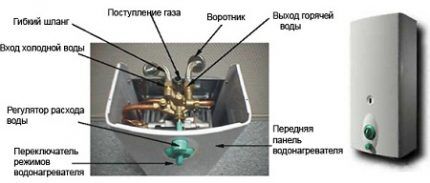
The process of heating water is accompanied by the precipitation of hard sediment, which gradually accumulates inside the heat exchanger. The tubes become clogged with deposits, as a result, the heating quality deteriorates, operation instantaneous water heater becomes insufficiently effective.
Regular cleaning of the column will help avoid such problems. In addition to scale, other contaminants can accumulate inside the device, it all depends on the quality of the water.

The following signs indicate that it is time to clean the column:
- the pressure from a hot water tap is much weaker than the stream from a cold tap;
- the pressure is good, but almost immediately after switching on the column goes out;
- the device stopped turning on altogether, regardless of the pressure;
- there is insufficient heating of the flow compared to the previous state;
- The water heats up to the desired temperature, but too slowly.
Some malfunctions can also be observed when the shut-off valve, which is installed at the entrance to the dispenser, breaks down. It doesn’t hurt to check it first, and only then start cleaning.
Descaling procedure
To flush the heat exchanger with normal geyser, you should first find the valves that shut off the flow of gas and water to the device, and then turn them.
At the same stage, it is recommended to obtain the operating instructions and refresh your memory about the device’s design, as well as the manufacturer’s recommendations. This will avoid mistakes during dismantling.
To disassemble the column, you will need the usual tools that any experienced craftsman has at his disposal:
- adjustable and pipe wrench;
- straight and Phillips screwdrivers;
- paronite gaskets;
- a hose at least half a meter long;
- a metal clamp to secure this hose.
The hose is connected to the outlet of the heat exchanger and lowered into the sink so that waste water with contaminants can be drained into the sewer. If this is not possible, you will also have to stock up on a large enough container to drain the water. The protective casing is removed from the column. Be careful not to break the control panel.
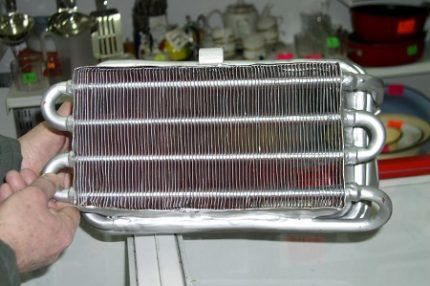
Now you need to remove water filter, which is usually secured with a nut. The filter should then be washed and replaced. If the deposits prove to be too complex, it is recommended to use chemical cleaners to remove contaminants from the mesh. During the washing process, damage to the filter may be detected. In this case, it is better to replace it.
Now you need to disconnect the heat exchanger from the water pipes; usually in these places a regular threaded connection is used, which should simply be unscrewed. The heat exchanger is removed from its hinges and turned over. Some craftsmen advise placing it in a large enough container during cleaning so that aggressive chemicals do not leak onto the floor.
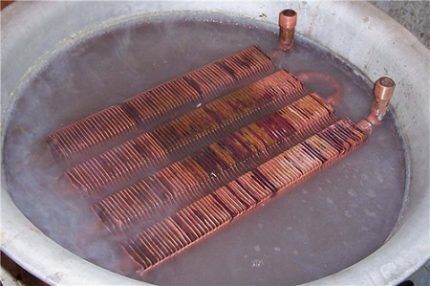
Suitable products can be used as a cleaner, for example, Antiscale. A regular 9% vinegar solution and other household compositions will also work. You can make a solution of citric acid: 100 g per liter of water.
Some have had positive experiences descaling with drinks like Pepsi-Cola or Sprite, which contain phosphoric acid. But you should not use vinegar essence for these purposes, it can corrode the walls of the pipes, and serious repairs will have to be carried out.
The heat exchanger is turned over and the cleaner is poured into it using a rubber bulb or a large syringe. Usually you need at least 500 ml of the substance, but no more than a liter. After this, vinegar or citric acid is left inside for about a quarter of an hour. When using industrial cleaners, it is recommended to follow the instructions.
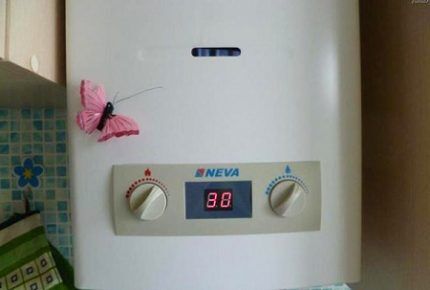
At the end of cleaning, the solution is drained and the pipes are washed to remove accumulated dirt. To do this, the inlet of the heat exchanger is again connected to the water supply, and a container is placed at the outlet to collect dirty water.
Flushing is carried out until a clean stream appears. If there is serious contamination, a one-time cleaning procedure may not be enough; it will have to be repeated again, using a fresh portion of the cleaner.
Upon completion of the work, it is necessary to reassemble the column in the reverse order. The heat exchanger is connected to the water supply.In this case, the threaded connections should be sealed and treated with graphite lubricant. All gaskets present at the installation sites must be immediately replaced with new ones.
Now you need to replace the washed coarse filter, put the casing on the device and again supply gas and water to the column by unscrewing the corresponding valves. All that remains is to perform a test run of water to make sure that the column is working properly.
Cleaning the heat exchanger without dismantling
There is also a way to clean the heat exchanger without completely dismantling it. To do this, you must first remove the casing from the device and disconnect the water supply pipe from the heat exchanger. The inlet copper tube of the coil should be slightly shifted to make it easier to work with.
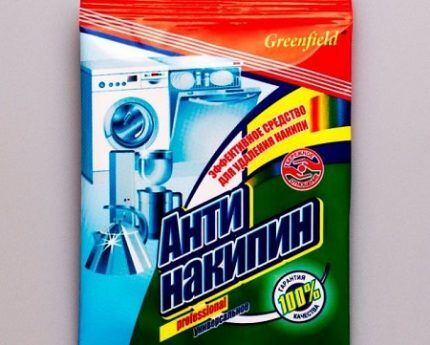
A hose is put on the outlet pipe. Then you need to open the tap and drain a little water, about a liter, to free the coil from liquid. If it is possible to clarify the heat exchanger capacity in the technical data sheet geyser, then it is recommended to drain exactly that amount of water or a little more from the system.
To clean the column using this method, it is better to take Antiscale powder, which is diluted with hot water before use. It doesn’t hurt to take care to protect your skin and eyes from accidental exposure to the composition, since it contains hydrochloric acid.
Now you need to insert a funnel into the inlet pipe and pour Antiscale into the heat exchanger. It should be remembered that when pouring quickly, a reaction may begin inside, which will lead to the ejection of the dangerous solution in the opposite direction.Therefore, you need to pour the composition in small portions and in a thin stream.
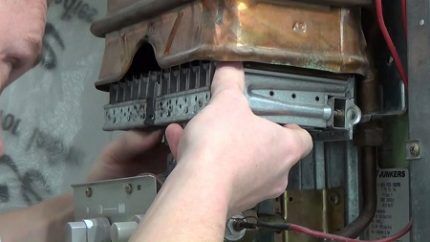
The heat exchanger filled with solution should be left for about two hours. To speed up the cleaning process, you can turn on the igniter (it is not necessary to turn off the gas for this cleaning method). When the process is over, you should open the tap and drain the water with the sludge dissolved in it from the column.
If a lot of contaminants come out and the jet shows good pressure, cleaning can be considered satisfactory. If not, you need to carry out the procedure again, but when using Antiscale, such a need usually does not arise.
This cleaning method is recommended to be carried out using just such a cleaner. The use of vinegar or citric acid in this case can have a bad effect on the condition of the aluminum gearbox.
Removing contaminants from combustion products
Soot, soot and other solid combustion products, although formed in such devices in small quantities, can still cause serious damage.
If you need to clean this part of the device, you need to remember the manufacturer's instructions again, especially if the warranty period has not yet expired. Some manufacturers require that such work be carried out only by professional gas fitters.
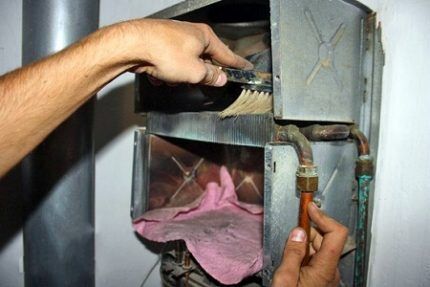
The easiest way is to clean the column radiator from combustion products. To do this, turn off the gas and remove the protective casing from the device.After this, the surface of the element is treated with a regular household vacuum cleaner.
If the gas in the column does not ignite, or burns unevenly and weakly, the injectors may be clogged. To clean them from accumulated layers of soot, use a thin wire or a brush with metal bristles.
Of course, in this case, you should turn off the gas and remove the casing. Cleaning must be done carefully so as not to damage the elements of the device.
When soot accumulates too quickly, it makes sense to think about the presence of other faults that provoke this situation. A common reason for this phenomenon is a leak at the joints of the gas tubes inside the column.

The gap may be so small that it is not possible to detect the leak by smell. If you suspect a malfunction of this type, apply a soapy solution to the connections and then apply gas to the device.
If the solution begins to bubble, you should stop work, turn off the gas and immediately call an experienced gas technician. Self-indulgence at this stage can be fatal.
The water pressure is normal, the soot has been removed, but the column still does not turn on? Now is the time to check your traction. Modern models usually have special sensors that detect the lack of draft and do not allow the device to be turned on, cutting off the gas supply to the ignition device.
To check, it is better to use strips of thin paper. The flame of a candle or lighter can be dangerous if the problem is caused by a gas leak.
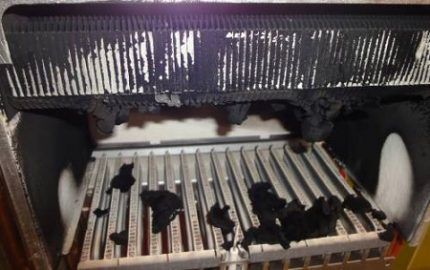
Having discovered weak traction, it is necessary to identify the cause of the situation. Usually it is enough to clean the chimney to restore normal operation of the appliance. If this does not help, you should consult with a gas equipment engineer; there may be flaws made during the installation of the chimney structure.
Preventing scale formation
Hard water is not the only cause of scale build-up inside heat exchanger tubes. For its appearance, you need not only the salts contained in the water, but also a high heating temperature. The hotter the gas burns, the more intense the solid deposit inside the device. Temperatures of 80 degrees or higher are considered critical.
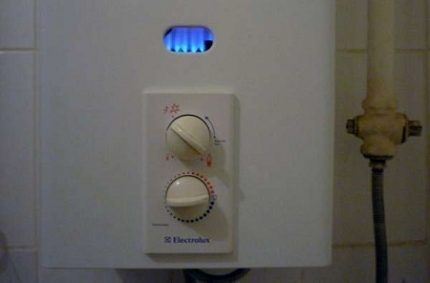
Obviously, such high heating is not needed for domestic use. For a shower, 40-42 degrees is enough; for washing even the dirtiest dishes, 45 degrees is enough. An automatic washing machine will heat the water up to 95 degrees, if necessary, but the gas water heater does not participate in this process in any way.
Therefore, if hot water constantly has to be diluted with cold water, it is worth reconsidering geyser settings according to heating temperature. Some amateur craftsmen drill out the igniter of a gas water heater. This is done in order to increase the heating rate of the water flow.
In older models, this modification eliminates the need to light up and adjust the device every time you turn it on.Finally, a drilled igniter is needed to ensure that the gas ignites even with very low water flow pressure.
In this case, a very dangerous situation can arise when a small amount of water in the heat exchanger boils and goes into gaseous form. As a result, the pressure in the heat exchanger will increase sharply and it will simply burst.
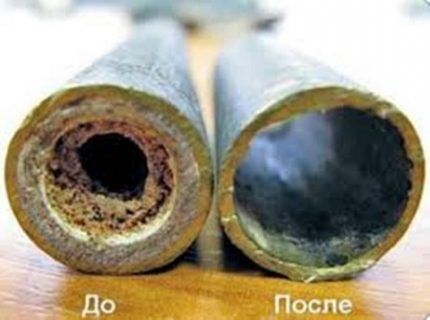
Of course, gas workers consider such intervention dangerous, and manufacturers refuse to fulfill warranty obligations for devices with such modifications. To improve system pressure, you can pick up and install a regular one circulation device or booster pump. And the quality of the water supply will improve, and the devices will not be damaged.
Conclusions and useful video on the topic
An interesting option for flushing a gas water heater can be found in this material:
The procedure for cleaning the heat exchanger without dismantling is demonstrated here:
This video shows an interesting experiment on dissolving scale in electrolyte, citric acid and vinegar. Although it is necessary to take into account not only the effect of chemistry on the hard sediment, but also on the material from which the heat exchanger is made:
Any geyser needs periodic cleaning. If maintenance is performed correctly, the device will work long and efficiently.
Would you like to talk about how you cleaned a gas instantaneous water heater yourself? Do you have information on the topic of the article that will be useful to site visitors? Please write comments in the block below, ask questions and post photos on the topic of the article.




Good, interesting and informative information, but still, I think it is better to entrust this matter to representatives of the gas service.
The column is not a joke; here you need to fully understand the specifics of its work. If it’s for self-development, then it’s worth knowing the intricacies of the device, but in practice I wouldn’t try to clean the speaker myself. For this purpose, there are specially trained people who will do everything, and will also give a guarantee for their work!
“Specially trained people” will take a lot of money, but it’s not a fact that they are great specialists. And they certainly don’t work for themselves.
Citric acid is the best descaler.
I have been cleaning the gas heater in my mother's house myself for several years now. Usually before the start of the heating season. At the same time I'm checking the AGV. It's actually simpler than it seems at first glance. Of course, you need to know at least the slightest idea about the structure of the device and the specifics of its operation. The rest can be easily found on the Internet. The main thing to remember is that you need to act very carefully and follow the instructions strictly. I myself would not recommend using any folk methods, such as citric acid, etc. After all, there are special means for this, like the same “Antinakipin”. It will cost several times less than calling a “specialist” who will look at your column several times with a very thoughtful look.
About the video “We wash the column without dismantling.” Couldn't it be simpler?
1. Turn off the water.
2. Open the hot water tap.
3. Unscrew the filter.
4. Blow into it several times so that the remaining water in the system comes out through the open hot water tap.
5. Lemonka, etc...